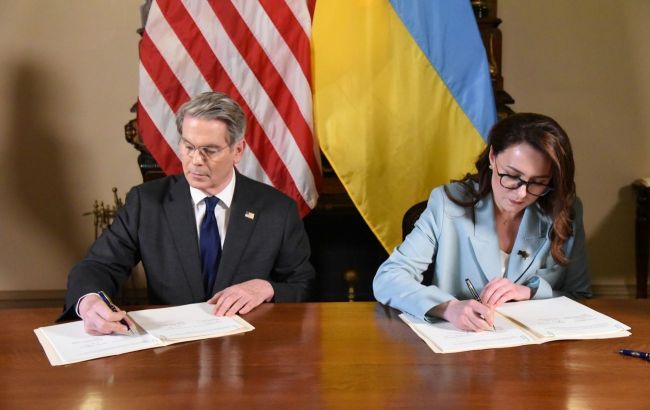Ukraine-US minerals deal: Details, key terms, and what's next
 Photo: Ukrainian Economy Minister Yulia Svyrydenko and US Treasury Secretary Scott Bessent (facebook.com/yulia.svyrydenko)
Photo: Ukrainian Economy Minister Yulia Svyrydenko and US Treasury Secretary Scott Bessent (facebook.com/yulia.svyrydenko)
Ukraine and the United States signed an agreement to establish a US-Ukraine Reconstruction Investment Fund with equal participation of the parties. The funds will be used to finance new Ukrainian projects ranging from mining to infrastructure, while Ukraine retains full control over minerals.
Read more about the content of the agreement and what will happen after its signing in the RBC-Ukraine's report below.
Takeways
- What agreement did Ukraine and the US sign in Washington?
- How will the new reconstruction fund work?
- What minerals are included in the document?
- What guarantees will Ukraine receive under this agreement?
- What happens next after the signing?
- When can the Ukrainian Parliament consider ratification of the agreement?
- What is the text of the Ukraine-US Economic Partnership Agreement?
The two countries signed the agreement in Washington after months of sometimes tense negotiations, with uncertainty persisting until the very last moment. The agreement was signed by Yulia Svyrydenko, First Vice Prime Minister and Minister of Economy of Ukraine, and Scott Bessent, US Treasury Secretary.
What Ukraine says about the agreement: terms, guarantees, mechanisms
According to the Ukrainian government, the Reconstruction Investment Fund will provide financing for critical projects in the field of mineral development and will promote innovation, technological development, and recovery.
"The Agreement will benefit both nations. The United States will assist Ukraine in engaging both private and public investors in Ukraine’s recovery — including international funds, companies, and the governments that have consistently supported Ukraine during the full-scale war," the Cabinet of Ministers website says.
American companies will have access to new opportunities offered by the joint development of natural resources and the restoration of Ukraine.
Key guarantees for Ukraine:
- Compliance with the Constitution and the EU course. The agreement is consistent with the current legislation and Ukraine's international obligations.
- Full control over resources. All minerals, territorial waters, and resources remain the property of Ukraine. Only Ukraine determines the conditions and places of extraction.
- Preservation of state property. State-owned companies remain in the ownership of Ukraine. The agreement does not affect privatization processes. Companies such as Ukrnafta or Energoatom remain state-owned.
- Optimal legislative changes. Only limited amendments to the Budget Code of Ukraine are required for the fund to function. The Agreement itself will be subject to ratification by the Verkhovna Rada.
According to the draft document, it does not provide for any specific US security guarantees for Ukraine, as Kyiv initially insisted.
However, an important diplomatic victory for Ukrainian negotiators was the fact that the signed agreement does not demand compensation or any obligation to pay the debt for the military assistance provided to Ukraine.
Earlier, US President Donald Trump had repeatedly publicly stated that Ukraine should compensate for the assistance provided by the United States. He voiced different amounts, often changing them. At first, he talked about $500 billion that the United States had allegedly already spent to support Kyiv. Then he reduced the figure to 350 billion, and later to 100 billion.
How the fund will work:
- The agreement focuses on future, not past, US military assistance. The document does not mention any debt obligations of Kyiv to Washington.
- Guaranteed investors and buyers. The fund will invest in projects and guarantee commercial purchases of products on a take-or-pay basis.
- The fund will be filled with contributions from the United States and Ukraine. In addition to direct funds, the United States may contribute new assistance, such as air defense systems for Ukraine.
- Equal partnership. The fund is created on a 50/50 basis. Neither party will have a majority vote. It is about cooperation for decades to come.
Thus, Ukraine will allocate 50% of future revenues from new royalties on new licenses for new areas (in the field of critical raw materials, oil, and gas) to the fund. Revenues from existing projects or budgeted revenues are not included in the fund. Ukraine can also make additional contributions beyond this basic one if it deems it necessary.
- The fund then invests in mining and oil, and gas projects, as well as related infrastructure or processing. Ukraine and the United States will jointly determine the specific investment projects to which the funds will be allocated.
- The fund is invested exclusively in Ukraine, in upstream projects or infrastructure rehabilitation.
- For the first 10 years, profits are not distributed but are fully reinvested in the Ukrainian economy (in new projects or reconstruction). After that, they can be distributed among the partners. These conditions will be discussed further.
- The US will help attract additional investment and technology to the Ukrainian economy.
That is, the fund is supported by the US government through the US Agency for International Development (DFC), which will help attract investment and technology from funds and companies in the United States, the EU, and other countries that support Ukraine's fight against Russia. Technology transfer is an important component of the agreement, as Ukraine needs not only investment but also innovation.
- The agreement provides tax guarantees. The fund's income and contributions are not taxed in the United States or Ukraine.
What US says
The US Treasury Secretary said that this economic partnership agreement allows both countries to work together and invest together to ensure that shared assets, talent, and capabilities can accelerate Ukraine's economic recovery.
According to Bessent, under Trump's leadership, the US Treasury Department and DFC will work with the Ukrainian government to finalize program management and advance the partnership.
"This agreement signals clearly to Russia that the Trump Administration is committed to a peace process centered on a free, sovereign, and prosperous Ukraine over the long term," the US Treasury Secretary emphasized.
He also noted that the US President sees this partnership between the American and Ukrainian peoples as a testament to the mutual desire for lasting peace and prosperity in Ukraine.
"And to be clear, no state or person who financed or supplied the Russian war machine will be allowed to benefit from the reconstruction of Ukraine," Bessent summarized.
Trump himself, commenting on the agreement for the first time, said that it would protect US investments and financial assistance provided by the United States to Ukraine.
"We made a deal today where we get, you know, much more in theory, than the $350 billion but I wanted to be protected," he said.
The White House chief of staff also said that in the Vatican, during a conversation with Ukrainian President Zelenskyy, he insisted on signing an agreement to end the war because, as he said, Russia is bigger and stronger than Ukraine.
Asked whether a deal on subsoil between Ukraine and the United States would deter Russian dictator Vladimir Putin, Trump replied: "Well, it could."
In turn, US Secretary of State Marco Rubio called the agreement with Ukraine an important step in ending the war.
What's next?
According to Taras Kachka, Deputy Minister of Economy of Ukraine, the next step will be the ratification of the agreement in the Verkhovna Rada.
It is noteworthy that yesterday, before the signing, Prime Minister Denys Shmyhal said that on May 1, the government would hold consultations with the heads of factions, groups, and the leadership of the Verkhovna Rada on the ratification of the agreement on Ukrainian minerals with the United States.
"This is an agreement that requires the consent of the Verkhovna Rada. This is directly stated in the agreement itself. Therefore, it is obvious that we will start consultations with the Parliament and present it as transparently as possible. The deal is unique, and there were a lot of horror stories in the media," Kachka explained.
According to the deputy economy minister, after the agreement is ratified, the fund itself will be set up between the US DFC and a Ukrainian agency operating under the Ministry of Economy.
"A legal framework will be created between the two agencies. And that's it - work on making investments will begin," Kachka added.
However, according to MP Yaroslav Zhelezniak of the Holos party, the ratification of the document will not take place this week or even next week.
"The nearest date is May 13-15, and that is if they manage to submit everything to the Rada. Interstate agreements have separate procedures that are difficult to speed up. And today, the Prime Minister has to come to the Rada and present it to the factions. Therefore, the collection of votes will only begin," Zhelezniak said.
He also gave his explanation of what would happen next. According to him, the United States and Ukraine have signed the first part: the political intergovernmental agreement, which mostly outlines general wording. This is the document that needs to be ratified.
"Then there are two more parts: an agreement between the DFC and the Agency from Ukraine (this is after ratification) (and - ed.), the technical part of how it will work and be distributed," he added.
Text of the agreement
Later, the Ukrainian government revealed the text of the agreement concluded between the Ukrainian and American parties. The document states that the agreement may be amended from time to time following its provisions. The agreement is valid until the parties agree to terminate it.
"This Agreement strengthens the strategic partnership between the Parties for the long-term reconstruction and modernization of Ukraine, in response to the large-scale destruction caused by Russia's full-scale invasion of Ukraine and in pursuit of a peaceful, sovereign, and resilient Ukraine," the document says.
The document shows that the agreement on minerals covers 57 types of minerals. Assets related to natural resources means areas, reserves and deposits on the territory of Ukraine of aluminum, antimony, arsenic, barite, beryllium, bismuth, cerium, cesium chromium, cobalt, copper, dysprosium, erbium, europium, fluorine, fluorspar, gadolinium, gallium, germanium, gold, graphite, hafnium, holmium, indium, iridium, lanthanum, lithium lutetium, magnesium, manganese, neodymium, nickel, niobium, palladium, platinum, potassium, praseodymium, rhodium, rubidium, ruthenium, samarium, scandium, tantalum, tellurium, terbium, thulium, tin, titanium, tungsten, uranium, vanadium, ytterbium, yttrium, zinc, zirconium, oil, natural gas (including liquefied natural gas) and other minerals or hydrocarbons.
Among other things, the document states that if, after the effective date, the United States provides Ukraine with new military assistance in any form (including the transfer of weapons systems, ammunition, technology, or training), the capital contribution of the US partner will be considered increased by the estimated value of such military assistance.
In the event of any inconsistency between Ukrainian law and the agreement, the agreement will prevail. The Government of Ukraine agrees that it may not invoke the provisions of its domestic law as a justification for any failure to fulfill its obligations under the agreement.
The signing of the bilateral agreement between Ukraine and the United States was preceded by a memorandum that served as the basis for negotiations on the future agreement. It contained general principles on which cooperation would be based.
Although the memorandum did not have the legal force of a treaty and did not contain clear guarantees or specific obligations, it set out the countries' common intentions to conclude a large-scale economic partnership agreement. One of its key elements is the creation of this investment fund.
Read more about this and the path to the signing of the subsoil agreement between Ukraine and the United States in an RBC-Ukraine article.
Sources: the government portal, statements by Prime Minister Denys Shmyhal, Minister of Economy of Ukraine Yulia Svyrydenko, US Treasury Secretary Scott Bessent, US President Donald Trump, US Secretary of State Marco Rubio, Deputy Minister of Economy of Ukraine Taras Kachka, and the Telegram channel of MP Yaroslav Zhelezniak.

